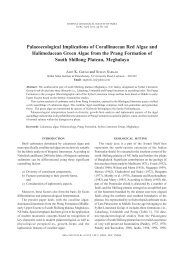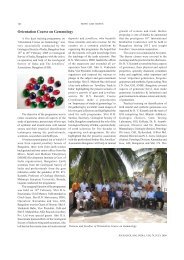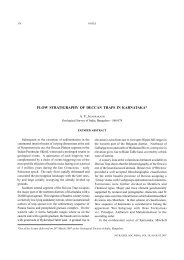Full text in PDF - Geological Society of India
Full text in PDF - Geological Society of India
Full text in PDF - Geological Society of India
Create successful ePaper yourself
Turn your PDF publications into a flip-book with our unique Google optimized e-Paper software.
408 ANIKET CHAKRABARTY AND AMIT KUMAR SEN<br />
Table 3. Whole rock trace elements analyses <strong>of</strong> representative carbonatites (C), alkali-pyroxenites (Pxn) and apatite-magnetite rocks (Apt-Mt)<br />
Sample No. 1 2 3 4 5 1 2 3 4 5 1 2<br />
Rock type C C C C C Pxn Pxn Pxn Pxn Pxn Apt-Mt Apt-Mt<br />
La 390.26 434.44 424.24 423.43 460.58 109.32 121.01 129.03 154.95 114.98 397.17 422.12<br />
Ce 666.20 730.01 735.35 725.19 833.28 248.15 270.46 302.50 347.46 256.13 891.85 953.88<br />
Nd 295.16 336.39 341.24 329.79 373.82 113.10 114.86 138.68 152.96 111.45 509.84 537.76<br />
Sm 41.71 45.26 48.09 46.21 48.29 18.62 19.62 23.25 24.67 18.87 82.24 86.64<br />
Eu 11.40 12.33 13.27 12.77 12.58 5.01 5.27 6.34 6.55 5.20 22.43 24.04<br />
Gd 30.59 33.03 35.25 33.87 34.69 12.63 13.42 15.73 16.82 12.79 54.31 57.60<br />
Tb 4.07 4.45 4.66 4.59 4.52 1.76 1.87 2.21 2.36 1.79 6.96 7.45<br />
Dy 17.48 18.43 19.53 19.28 19.06 7.75 8.15 9.32 10.09 7.71 25.27 26.64<br />
Ho 3.68 3.76 3.99 3.97 3.81 1.54 1.69 1.85 2.03 1.58 4.25 4.46<br />
Er 7.44 7.65 7.89 7.97 7.87 3.02 3.33 3.58 3.97 3.08 7.50 7.91<br />
Tm 0.93 0.93 0.94 0.99 0.93 0.35 0.40 0.40 0.46 0.36 0.65 0.67<br />
Yb 5.27 5.36 5.37 5.57 5.39 2.04 2.35 2.27 2.59 2.11 3.20 3.34<br />
Lu 0.65 0.66 0.66 0.68 0.68 0.26 0.30 0.28 0.31 0.26 0.34 0.36<br />
Sc 1.24 1.18 2.05 1.47 1.79 21.50 20.16 19.93 17.70 19.96 10.85 11.30<br />
Y 84.18 86.97 89.63 90.12 87.93 32.55 36.45 38.99 43.60 34.28 77.58 81.70<br />
Nb 21.13 28.03 43.78 19.60 44.49 209.65 325.16 314.81 336.85 261.34 95.74 146.24<br />
Th 2.63 2.89 5.08 4.47 5.51 2.89 3.03 4.42 3.34 2.32 4.11 5.19<br />
Sr 8609.33 8592.00 8401.46 8699.16 8807.14 1720.81 1936.99 1616.02 2181.60 1868.77 3353.00 3486.94<br />
Rb 0.85 1.16 0.54 1.31 2.22 52.54 42.96 77.27 77.12 70.46 0.23 0.30<br />
Ba 1483.54 1515.18 1428.83 1434.86 1488.88 850.63 771.00 1019.28 1025.95 1089.15 618.16 658.56<br />
V 11.24 9.46 12.94 15.23 14.47 345.54 311.35 329.97 320.01 326.31 14.62 15.46<br />
U 6.28 7.86 10.90 5.94 11.66 1.82 1.93 1.92 1.16 1.61 4.92 5.17<br />
Ga 19.63 19.96 19.25 19.29 22.12 27.87 24.46 29.85 29.00 30.62 8.64 9.28<br />
Pb 5.41 8.69 4.92 7.16 5.62 8.00 3.66 7.25 8.23 4.91 11.00 15.00<br />
Li 0.41 0.50 0.48 0.53 0.73 13.00 11.37 16.33 16.64 15.55 0.24 0.36<br />
ΣREE 1474.84 1632.70 1640.48 1614.31 1805.50 523.55 562.73 635.44 725.22 536.31 2006.01 2132.87<br />
La/Yb 74.05 81.05 79.00 76.02 85.45 53.59 51.49 56.84 59.83 54.49 124.12 126.38<br />
Ba/La 3.80 3.49 3.37 3.39 3.23 7.78 6.37 7.90 6.62 9.47 1.56 1.56<br />
Nb/Pb 3.91 3.23 8.90 2.74 7.92 26.21 88.84 43.42 40.93 53.23 8.70 9.75<br />
Nb/Th 8.03 9.70 8.62 4.38 8.07 72.54 107.31 71.22 100.85 112.65 23.29 28.18<br />
Y/Ce 0.13 0.12 0.12 0.12 0.11 0.13 0.13 0.13 0.13 0.13 0.09 0.09<br />
Th/U 0.42 0.37 0.47 0.75 0.47 1.59 1.57 2.30 2.88 1.44 0.84 1.00<br />
Y/Ho 22.88 23.13 22.46 22.70 23.08 21.14 21.57 21.08 21.48 21.70 18.25 18.32<br />
difference observed with that <strong>of</strong> the carbonatite is the<br />
higher concentration <strong>of</strong> Rb and Nb (Fig. 3a). The higher<br />
concentration <strong>of</strong> Rb <strong>in</strong> alkali-pyroxenite can be attributed<br />
to the presence <strong>of</strong> pyroxene and mica. On the other hand,<br />
Nb enrichment is ma<strong>in</strong>ly due to the presence <strong>of</strong> niobo-rutile<br />
<strong>in</strong> alkali pyroxene (Chakrabarty, 2009). The most noticeable<br />
feature <strong>of</strong> the alkali-pyroxenite is the higher concentration<br />
<strong>of</strong> Sr. This is ma<strong>in</strong>ly due to the presence <strong>of</strong> late stage<br />
carbo(hydro)thermal carbonatite ve<strong>in</strong>s <strong>of</strong> apatite-calcite<br />
dur<strong>in</strong>g metasomatic alteration <strong>of</strong> the primary magmatic<br />
alkali-pyroxenite. The chondrite normalized REE plot<br />
(Fig.3b) reveals that the trend is very similar with that <strong>of</strong><br />
the carbonatite. However, both the ΣREE (596.65) as well as<br />
(La/Yb) (avg)<br />
(37.53) are lower compared to the carbonatite.<br />
Apatite-magnetite<br />
M<strong>in</strong>or differences are noticed <strong>in</strong> the primitive mantle<br />
normalized spider variation diagram between the apatitemagnetite<br />
rock and carbonatite (Fig.3a). The chondrite<br />
normalized REE pattern (Fig.3b) reveals that the apatitemagnetite<br />
rock is characterized by the highest ΣREE (>2000)<br />
concentration compared to the carbonatite and alkalipyroxenite<br />
and particularly <strong>in</strong> MREE, a common trend for<br />
apatite associated with carbonatites (Brass<strong>in</strong>nes et al. 2005;<br />
Bühn et al. 2001). But the HREE concentration <strong>of</strong> this rock<br />
is lower compared to the carbonatite.<br />
DISCUSSION<br />
It has already been po<strong>in</strong>ted out <strong>in</strong> the ‘Introduction’ that<br />
genesis <strong>of</strong> carbonatite, <strong>in</strong> general, is an enigma and can be<br />
expla<strong>in</strong>ed by more than one mechanism. Two basic questions<br />
are to be answered <strong>in</strong> petrogenesis <strong>of</strong> Purulia carbonatite<br />
are (i) the process and/or processes responsible for the<br />
JOUR.GEOL.SOC.INDIA, VOL.76,OCT.2010

















